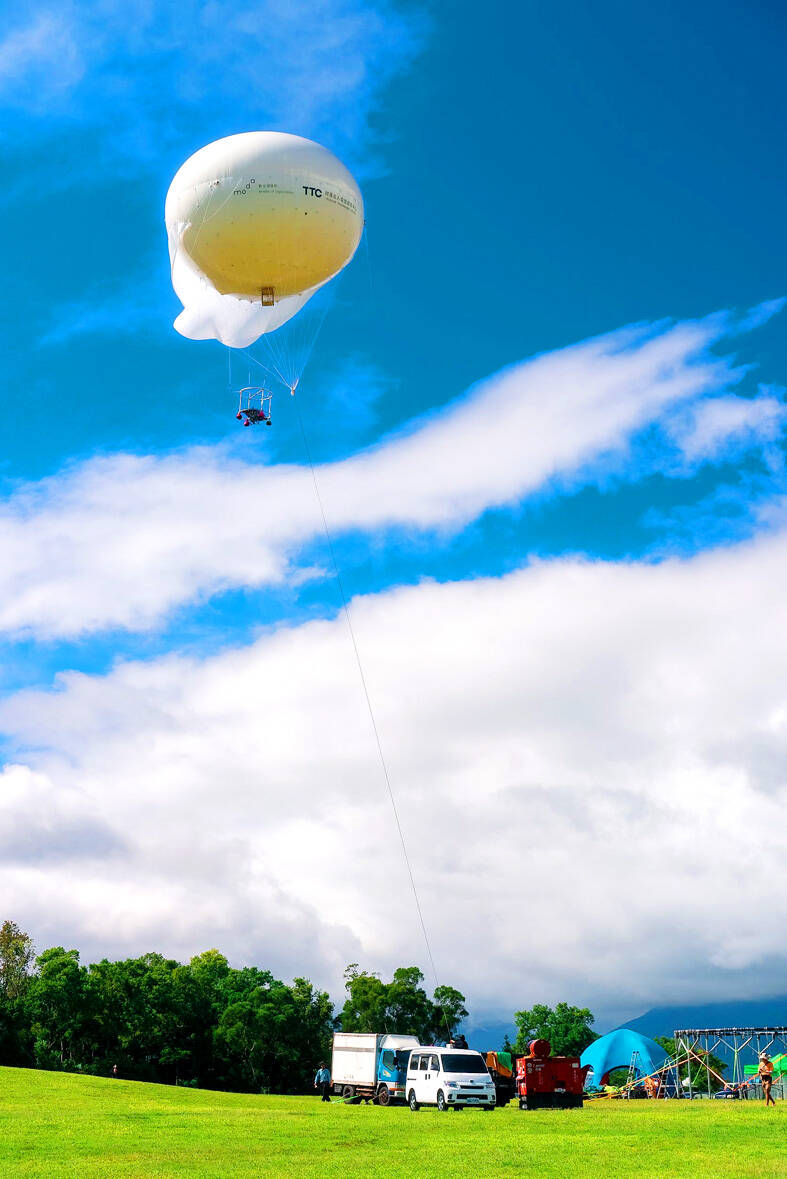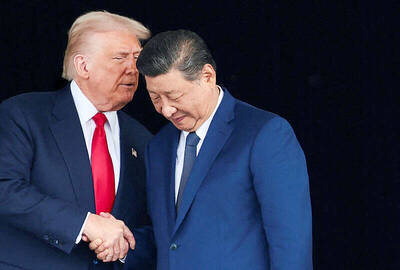The nation is developing a fleet of high-altitude balloons and drones to bolster Taiwan’s communications resiliency, the Ministry of Digital Affairs (MODA) said.
The high-altitude communications balloons and drones would serve as the backbone of an Internet network under the nation’s exclusive control, it said.
In October, Taiwan launched its first high-altitude communications balloon carrying hydrogen fuel cells and mobile base stations, MODA Department of Resource Management Director Niu Hsin-jen (牛信仁) told the Liberty Times (the Taipei Times’ sister paper) in a recent interview.

Photo courtesy of the Ministry of Digital Affairs
The program is a collaboration of the ministry, TH Aero Tech (天興航太), the Industrial Technology Research Institute, the National Taiwan University of Science and Technology, the National Taipei University of Science and Technology and the nation’s three main telecoms, Niu said.
The domestically developed and manufactured system is designed to control telecommunications networks across a 380km2 area during a military conflict or natural disaster, he said.
Balloons offer important advantages over other platforms, such as being inexpensive and easy to mass produce, making them resilient to attrition, he said.
Unlike satellite deployments that require negotiations with foreign governments on orbits and the usage of frequencies, balloons can use any frequency and be deployed at will within Taiwan’s airspace, he said.
The key technologies of the high-altitude balloons’ design and manufacturing are primarily sourced from the US, the UK, Japan and the Czech Republic, none of which pose a potential national security threat, Niu said.
Airships, balloons and drones are the main types of high-altitude station platforms that can be used for wireless communications, he said, adding that balloons were selected for their superior payload, loiter time and technological maturity.
The government did not develop airships due to the heavy energy consumption required for their deployment, Niu said.
The ministry is next year to increase the operational ceiling of balloons to 800m or higher, enable linkage between balloon-run networks to mimic the capability of satellite constellations and develop a drone-based platform station, he said.
The balloon-based, high-altitude platform station remains an experimental technology, but the potential for commercialization is substantial and could be achieved if a certification system is created, he said.

The Central Weather Administration (CWA) yesterday said it expected to issue a sea warning for Typhoon Fung-Wong tomorrow, which it said would possibly make landfall near central Taiwan. As of 2am yesterday, Fung-Wong was about 1,760km southeast of Oluanpi (鵝鑾鼻), Taiwan’s southernmost point, moving west-northwest at 26kph. It is forecast to reach Luzon in the northern Philippines by tomorrow, the CWA said. After entering the South China Sea, Typhoon Fung-Wong is likely to turn northward toward Taiwan, CWA forecaster Chang Chun-yao (張峻堯) said, adding that it would likely make landfall near central Taiwan. The CWA expects to issue a land

Taiwan’s exports soared to an all-time high of US$61.8 billion last month, surging 49.7 percent from a year earlier, as the global frenzy for artificial intelligence (AI) applications and new consumer electronics powered shipments of high-tech goods, the Ministry of Finance said yesterday. It was the first time exports had exceeded the US$60 billion mark, fueled by the global boom in AI development that has significantly boosted Taiwanese companies across the international supply chain, Department of Statistics Director-General Beatrice Tsai (蔡美娜) told a media briefing. “There is a consensus among major AI players that the upcycle is still in its early stage,”

The Central Weather Administration (CWA) yesterday said it is expected to issue a sea warning for Typhoon Fung-wong this afternoon and a land warning tomorrow. As of 1pm, the storm was about 1,070km southeast of Oluanpi (鵝鑾鼻), Taiwan’s southernmost point, and was moving west-northwest at 28 to 32kph, according to CWA data. The storm had a radius of 250km, with maximum sustained winds of 173kph and gusts reaching 209kph, the CWA added. The storm is forecast to pass near Luzon in the Philippines before entering the South China Sea and potentially turning northward toward Taiwan, the CWA said. CWA forecaster Chang Chun-yao (張峻堯) said

‘SECRETS’: While saying China would not attack during his presidency, Donald Trump declined to say how Washington would respond if Beijing were to take military action US President Donald Trump said that China would not take military action against Taiwan while he is president, as the Chinese leaders “know the consequences.” Trump made the statement during an interview on CBS’ 60 Minutes program that aired on Sunday, a few days after his meeting with Chinese President Xi Jinping (習近平) in South Korea. “He [Xi] has openly said, and his people have openly said at meetings, ‘we would never do anything while President Trump is president,’ because they know the consequences,” Trump said in the interview. However, he repeatedly declined to say exactly how Washington would respond in